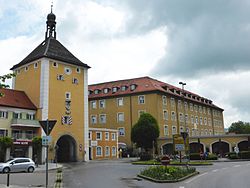|
Oflag VII-C
Oflag VII-C was a World War II German prisoner-of-war camp for officers located in Laufen Castle, in Laufen in south-eastern Bavaria from 1940 to 1942. Most of the prisoners were British officers captured during the Battle of France in 1940. To relieve overcrowding, some of the officers were transferred to Oflag VII-C/Z in Tittmoning Castle. The Oflag existed only for a short time. In early 1942 all the officers were transferred to Oflag VII-B in Eichstätt. The castle was then used as an Internment Camp Ilag VII for men from the British Channel Islands of Jersey and Guernsey until the camp was liberated in May 1945. Previously, in September 1944, after lengthy negotiations, 125 elderly and sick prisoners were repatriated to Great Britain via Sweden. In April 1944 the count of internees in Laufen included 459 British internees (417 Channel Islanders) and 120 American civilians who had been trapped in Europe when war was suddenly declared in December 1941. Even though the camp housed civilians, it continued to be operated by the German Army. The camp was liberated by the U.S. 3rd Army on 5 May 1945. Eight Channel Island internees died in Laufen camp during the period of internment.[1] Notable inmates
See also
References
POW memoirs
|
||||||||||||||||||||||||||
Portal di Ensiklopedia Dunia

